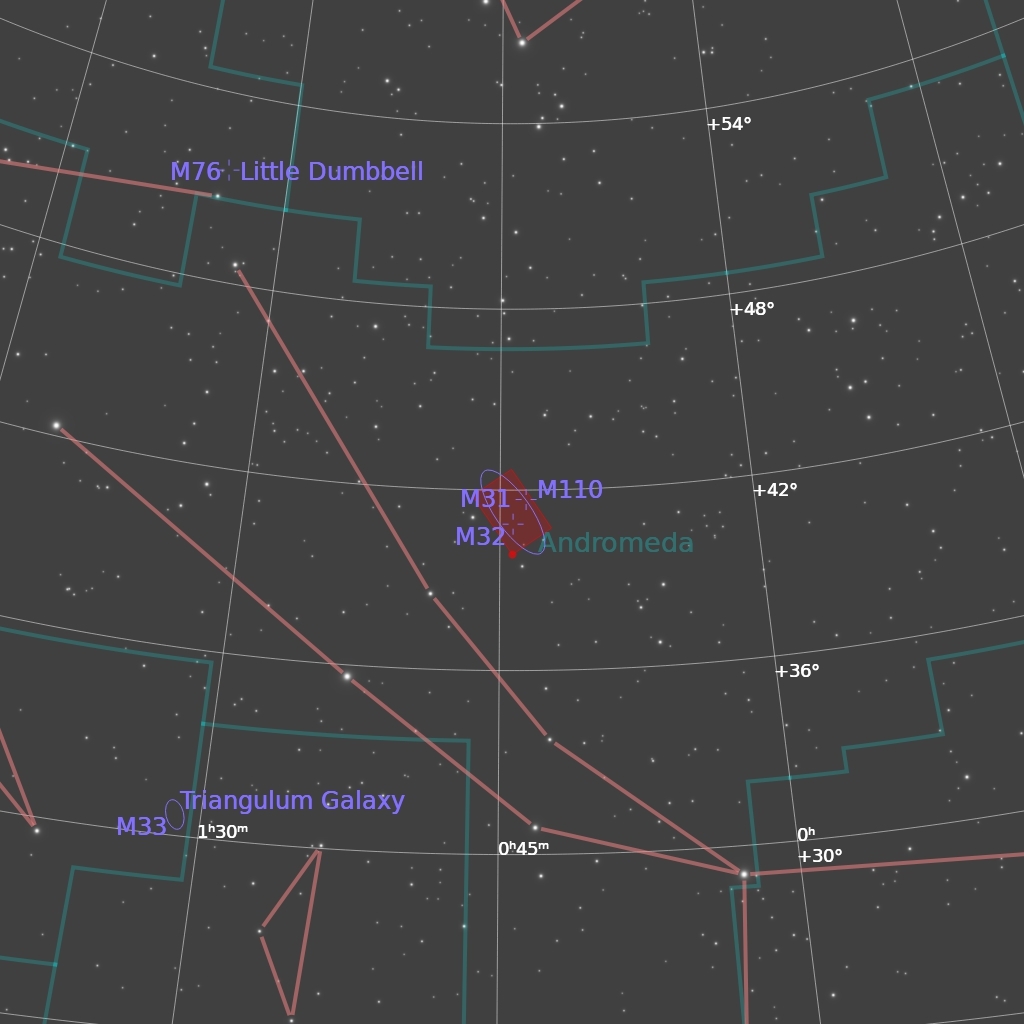Discovered by Charles Messier in 1773.
Messier 110 (M110, NGC 205) is the second brighter satellite galaxy of the Andromeda galaxy M31, together with M32, and thus a member of the Local Group of Galaxies.
Curiously, this galaxy was discovered by Charles Messier on August 10, 1773, as described in the Connaissance des Tems for 1801, and depicted on his fine drawing of the "Great Andromeda Nebula" and its companions published his memoir of these nebulae in 1807 (Messier 1807). However, Messier did never himself include this object in his catalog, due to unknown reasons, perhaps a certain sloppiness in recording. It was the last additional object, added finally by Kenneth Glyn Jones in 1966. Independent of Messier's discovery, Caroline Herschel independently discovered M110 on August 27, 1783, little more than 10 years after Messier, and assigned it to her small list under No. 9. William Herschel numbered it H V.18 when he cataloged it on October 5, 1784.
The small elliptical galaxy M110 is at about the same distance as the Andromeda galaxy M31; we adopt a value of 2.67 million light years which is a little more than M31's 2.6 Mly. It was confirmed as a galaxy near M31 by Walter Baade in 1944, when he resolved it into stars (Baade 1944). It is of Hubble type E5 or E6 and is designated "peculiar" because it shows some unusual dark structure (probably dust clouds). M110 is now often classified as a dwarf spheroidal galaxy, not a generic elliptical one (this would make it the first ever known dwarf spheroid, of course). However, as it is much brighter than typical dwarf spheroids, Sidney van dan Bergh has recently introduced the term "Spheroidal Galaxy" for this and similar galaxies, including Local Group members NGC 147 and NGC 185. M110's mass was estimated to be between 3.6 and 15 billion solar masses.
Apparently, despite its comparatively small size, this dwarf elliptical galaxy has also a remarkable system of 8 globular clusters in a halo around it. The brightest of them, G73, is of about 15th magnitude and thus within the reach of large amateur telescopes; Steve Gottlieb has observed it with a 44-cm telescope together with M31 globulars, and amateurs at the Ferguson Observatory near Kenwood, CA obtained a CCD image showing 7 of them with their 14-inch Newtonian and CB245 CCD camera.
Image Session Details
-Location: 50.23°N, 8.46°E
-Target: M31 (Andromeda Galaxy) + satellites M32, M110
-Integration: 300 × 35s = 2h 55m
-Camera: Nikon D3500 (APS-C DSLR) – ISO 400
-Telescope: Askar 103 APO + 0.8× reducer (546 mm)
-Mount: Bresser EXOS-2 + OnStep Belt
-Control: ZWO ASI AIR
-Guiding: SVBONY SV165 + ZWO ASI120MM Mini
-Sky Quality: Bortle 4, SQM ~20.8
-Moon Phase: Waning Gibbous (~88%)
-Filter: None
-Date: 12 August 2025
General Properties
Type: Elliptical galaxy, E5 pec
Coordinates: RA 00h40m22s, Dec +41°41′07″ (J2000)
Apparent Magnitude: 8.9 (V)
Angular Size: 21.9′ × 11.0′
Distance: 824 kpc (2.69 Mly)
Constellation: Andromeda
Discovery: First recorded by Charles Messier (1773); cataloged later as Messier 110.
Scientific Databases
[ POSITION ]
RA: 10.091905°
Dec: +41.685419°
Proper motion: pmRA=-1.71 mas/yr, pmDEC=-0.67 mas/yr
Redshift: -0.00082
Radial velocity: -246.0 km/s
[ PHOTOMETRY ]
Catalog: V=8.07, G=16.31, B=8.92
V: 8.07
B: 8.92
B–V: 0.85
Hubble type (from color): Sa
IRAS 12 µm: 0.25 Jy
IRAS 25 µm: 0.25 Jy
IRAS 60 µm: 0.59 Jy
IRAS 100 µm: 3.23 Jy
1.4 GHz flux: 0.01 Jy
[ DISTANCE ]
814000.00 pc (2.65 Mly, NED-D median, nDistance)
[ ALIASES ]
2MASX J00402207+4141070, IRAS 00376+4124, LEDA 2429, M 110, MCG+07-02-014, NGC 205, UGC 426
-NED
Observation Notes
-Visual Magnitude: 8.9
-Photographic Magnitude: 10.0
